4 Inches of Living Soil: Teaching Biodiversity in the Learning Gardens–A photo-essay
PHOTO ESSAY
In Learning Gardens and Sustainability Education: Bringing Life to Schools and Schools to Life, Williams and Brown (2011) place living soil at the center of the discourse on sustainability education. One of the seven principles that guides their pedagogy of learning gardens is: valuing biocultural diversity. This photo-essay of elementary students in K-8 schools, explores how 4 inches of soil in the learning gardens can teach about life’s diversity. The author urges humble attentiveness to that which is below our feet seemingly hidden and unnoticed yet teeming with life.
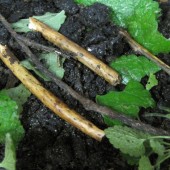 In my visits to over 80 school gardens across eight states, I have been struck by the fact that almost all of them have compost piles or bins, and many of them teach students about decomposition, composting, and soil. Art, science, math, poetry, and politics all emerge on school grounds that had in the past been either asphalted or manicured with lawns. Children and youth learn that there is no such thing as “out of sight, out of mind” waste. Instead, they are fascinated by the organisms they discover in the soil and also by soil’s mysteries when taught to observe soil with care. Composting as a way to “make” soil is slowly becoming common sight on school grounds.
In my visits to over 80 school gardens across eight states, I have been struck by the fact that almost all of them have compost piles or bins, and many of them teach students about decomposition, composting, and soil. Art, science, math, poetry, and politics all emerge on school grounds that had in the past been either asphalted or manicured with lawns. Children and youth learn that there is no such thing as “out of sight, out of mind” waste. Instead, they are fascinated by the organisms they discover in the soil and also by soil’s mysteries when taught to observe soil with care. Composting as a way to “make” soil is slowly becoming common sight on school grounds.
In locating biodiversity in the learning gardens, one need go no deeper than 4 inches of soil. Algae, ants, arthropods, bacteria, crickets, fungi, nematodes, millipedes, mites, molds, mushrooms, slugs, spiders, springtails, and ticks, among a myriad of other organisms, interact with one another and with the plant biomass to form a soil food web. A teaspoon of soil holds a billion invisible bacteria, several yards of invisible fungal hyphae, and thousands of other organisms including protozoans and nematodes (Lowenfels & Lewis, 2010). Decay, death, birth, and life play a dance impacting soil texture, smell, porosity, and color. More importantly, the basics of life itself surfaces in significant ways when we pay attention to that which is below our feet.
Soils have defined human societies historically and continue to do so today (Landa & Feller, 2010). As McNeil & Winiwarter (2006) explain:
Soils have their own histories, both natural and human. What people believe about soils influences (although does not determine) what they do with them, whether they conserve and nurture them, whether they abuse and abandon them. What people understand—and misunderstand—about soils is thus a necessary part of any history of the nexus between soil and society (pp. 2-3).
Thousands of learning gardens have sprouted and are established on school grounds providing learning opportunities to students of all ages, as biology, chemistry, physics, along with mathematics and language arts, are integrated with school learning (Williams & Dixon, forthcoming). For children, there can be no better place to commune with life than below the feet on school grounds. Beyond the distant outdoor field trips, children can connect to their own locale and the human-biotic community where learning is housed. In school learning gardens students can relate with soil, plants, food, and the nonhuman animal world. Soil is the frontier where nature, culture, and biology are intertwined, where humus teaches gratitude, where knowledge of decomposition becomes as critical as learning composition (Williams & Brown, 2011). The pedagogy of school learning gardens blurs the boundaries between the human animal and nonhuman vertebrate and invertebrate animal life. Meeting soil organisms as partners in the web of life, learning gardens invite children into kinship with life at a level deeper than words. As interlocutors of nature and life beneath our feet, learning gardens via living soil offer pathways toward organizing a pedagogy from below. Thus, to care about sustainability, we must care and be mindful about soil.
This photo-essay presents how soil curriculum is integrated on a daily basis in three sections of blended first and second grade classrooms at Sunnyside Environmental School (K-8), in Portland, Oregon and at Waters Elementary School (K-8), in Chicago, Illinois. Each photo is a snap-shot of the rich and diverse curricular integration that takes place. Students question, wonder, marvel, and make connections as they get their hands and feet soiled, and learn about biological diversity captured by living soil.
********
The soil is at once a living community of creatures and their habitat.
– Wendell Berry, 2009
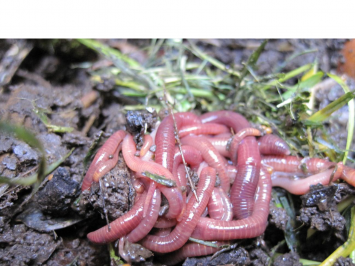
(1) Magnificence of the earthworm: Children’s fascination with earthworms is a known fact. In my visits, I have noticed children literally get into compost piles, bend over them, digging for earthworms. I have also seen them “find” earthworms that they readily pick from all over the grounds as they watch them wriggle in their palms. Older students learn how the earthworms are classified and how they reproduce. Often, it is difficult to know where poetry ends and science begins when students are engaged with life in soil.
It seems appropriate to pay tribute to the earthworm symbolizing the important life’s learnings.
Earthworm, A Tribute
Wriggling and mysterious,
Segmented.
Natural eating machine
Aerating soil,
Shredding organic matter, casting compost,
Life-sustaining, soil-making.
Earthworm.
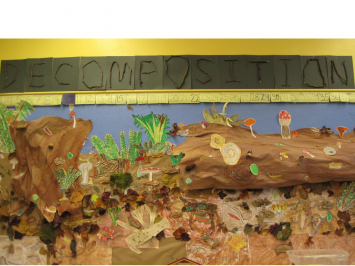
(2) Decomposition: Students learn that decomposition is as important as composition. At all grade levels students can be seen to learn about fungi, bacteria, leaves, and decomposing biomass—and in the process learning that soil is teeming with life. This is captured in a mural, integrating art and science. The mural was developed over two months of learning about how soil is formed and what forms soil. First and second grade students imagined what was underground and with each unit of soil study, their murals embodied character and details as seen in the photograph of a bulletin board spanning a wall in their urban classroom.
.
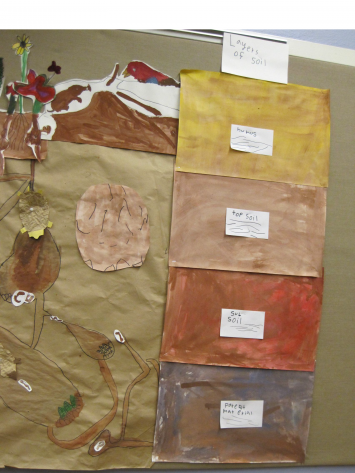
(3) Varying Layers of Types of Soil: Students take a close look at texture, porosity, and colors of soil from different parts of the school grounds. They become observant and study about humus, topsoil, parent soil, subsoil. They imagine the various organisms that form a web of life and interplay and discuss how soil quality affects all of life.
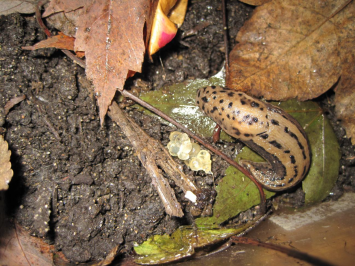
(4) Slugs, Slime, and Crystal Eggs: As part of the study of soil, students become researchers. They build terrariums by looking for all sorts of decaying matter in and around the school grounds. Leaves, woodchips, cones, needles, fruits, and more, are carefully placed in the terrarium along with some scooped up soil and then enclosed for daily close observation. One day, a group of students discovered that there was not only a slug that had “grown” in their terrarium but there were slimy shining crystal-like eggs, too. This discovery led to many questions as students took the initiative to investigate into how slugs reproduce and what other inhabitants might there be in the soil, not seen by the naked eye.
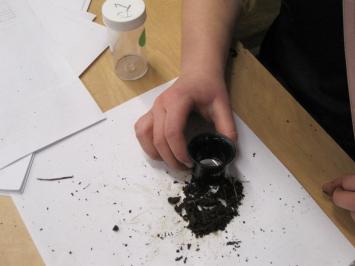
(5) Magnifying soil, looking for more: In a number of schools and classrooms, simple magnifying glasses are available for students to observe. With the use of microscopes from the laboratories, soil’s world changes in dramatic ways for students: they are enamored and simply stunned that what they thought was lifeless is actually teeming with life, magnified. Bacteria and protozoans appear to “swim” leading to investigation about who and what actually lives in soil.
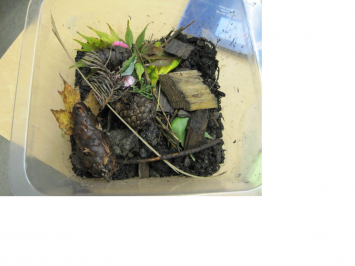
(6) Terrarium—Variety of decaying matter to create soil. A group of students brought living matter along with what they thought was “dead” matter to observe the cycle of change and how soil would form as long as they kept their terrarium aerated, as seen in this unique soil-supported life created by students.
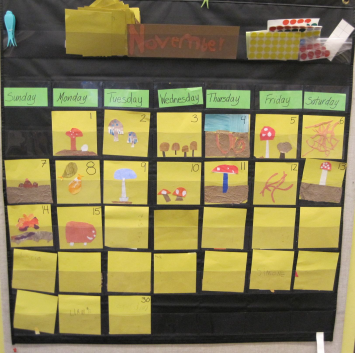
(7) Diversity of mushrooms in the soil: Students learned about mushrooms and fingi essential to the decay of matter. Their art work captures the diversity of mushrooms they “researched” as part of the unit on soil.
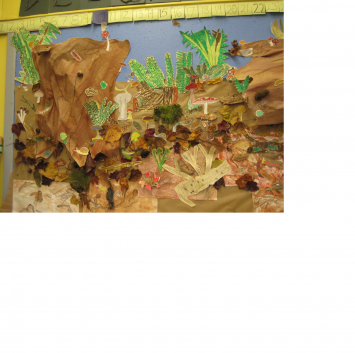
(8) Can you count the life in soil? A group of first graders could not wait to “turn the compost.” They took turns to lift the soil out of the compost pile even as they paused to examine the number of worms they found. The joy of soil being alive was evident in their squeals. According to Shiva (2008): “The millions of organisms found in soil are the source of its fertility. The greatest biomass in soil consists of microorganisms, fungi in particular. Soil microorganisms maintain soil structure, contribute to the biodegradation of dead plants and animals, and fix nitrogen… It is this amazing biodiversity that maintains and rejuvenates soil fertility” (p. 101). Living soil, thus, is an endless recursive food web.
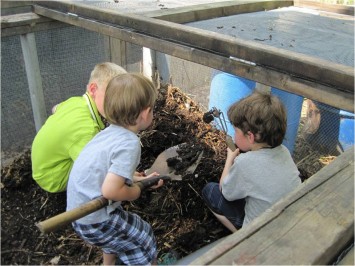
(9) What do we know already about decomposers? As first and second grade students explore soil, they learn that decomposition is a scientific term that is used for the normal term “rot.” Together, as a class, they are able to identify the various organisms, captured by their teacher, for the entire class to see.
Worms eat the plants and decompose them. They are good for the earth.
Mushrooms are decomposers too.
Different snails are decomposers.
Moles are decomposers.
Decomposed things sink into the ground and help other things grow.
Decompose is a scientific word for rot.
Decomposing is a cycle.
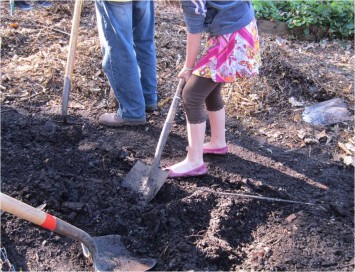
(10) Composted soil under chips left for a year. Middle school students were surprised that the bark chips they had left on the west side of their garden a year ago, actually had a layer of beautiful black soil underneath. They scraped off the remaining bark chips and decided to move the newly earthed soil to new beds they were creating for planting potatoes, digging out the upper layer of “rich soil,” as they called it.
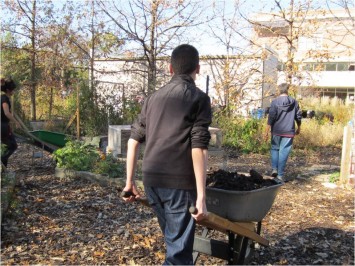
(11) Moving composted soil to create new bed for vegetable planting. With the help of a wheel-barrow, a student is enthusiastically moving the composted soil that the class discovered to the new bed.
Life’s diversity in 4 inches
Out of sight and out of mind, the vibrant life of living soil has largely been forgotten in traditional education. With concerns about the environment and for sustainability, pedagogy and curricular shifts are being accepted to include school gardens as a viable option. Learning gardens bring life to schools and schools to life through inviting children into relationship with the more-than-human world embodied in living soil (Williams & Brown, 2011). Viewing the complexity of soil counsels care in bold interactions and encourages curious and empathetic engagement with this dynamic entity. The new frontier for pedagogy is not to be sought in the gaze of stars but rather arises from below—it is beneath our feet in the school grounds. Soils and gardens serve as both poetic and scientific text as seen in this photo-essay. This snapshot represents a growing movement to connect students to life, by getting them to pay attention to and appreciate the worth of dirt and soil.
As one 6th grade Hispanic student noted, while trying to transplant a tomato seedling: “Dad says to keep the dirt with the plant. It’s full of nutrients.” She gently handled the roots, separating the fine threads and placing them into the hole she had created in the garden bed (Anderson, 2009). When children and youth gain this critical understanding of life and its biodiversity, there is hope for sustainability. Understanding 4 inches of soil might be an important step to learn about biodiversity. In the words of Thomas Barrett (1947), “The new frontier is beneath our feet.”
Connecting students with the more-than-human world of soil, children are brought into direct contact with a richly diverse animal and plant world often out of sight and out of mind. This contact sensitizes students to care about and value the diversity hitherto unnoticed. The dynamic aspects of school learning gardens can be understood by connecting with soil on school grounds. A mere 4 inches should suffice.
Note
Special thanks to teachers Peter Leki, Robin May, Abby Roth, and Rebecca Wagner for their care and wisdom in teaching children and youth about life and in doing so inspiring others to find wonder and joy in the mundane.
Photos
Courtesy, Dilafruz R. Williams
References
Anderson, J. (2008). Tongue-tied no more: Learning Gardens and social justice. Unpublished master’s research project. Portland State University, Oregon.
Barrett, T. J. (1947) Harnessing the earthworm. Boston: Bruce Humphries.
Berry, W. (2009). Bringing it to the table: On farming and food. Berkeley: Counterpoint.
Landa, E. R. and Feller, C. (Eds.). (2010). Soil and culture. London: Springer.
McNeill J. R. and Winiwarter, V. (Eds.). (2006). Soil and societies: Perspectives from environmental history. Isle of Harris: The White Horse Press.
Shiva, V. (2008). Soil not oil: Environmental justice in a time of climate crisis. Cambridge, MA: South End Press.
Williams, D. R., & Brown, J. D. (2011). Living soil and Learning Gardens: Bringing life to schools and schools to life. New York, NY: Routledge press.
Williams, D. R & Dixon, S. P. (Manuscript submitted). Impact of learning gardens on academic outcomes: Synthesis of research between 1990 and 2010.










 Dr. Dilafruz R. Williams is professor and co-founder of the Leadership for Sustainability Education (LSE) program at Portland State University, Portland, Oregon. She is co-author of Learning Gardens and Sustainability Education: Bringing Life to Schools and Schools to Life (Routledge) and co-editor of Ecological Education in Action: On Weaving Education, Culture, and the Environment (SUNY). She is recipient of several awards and grants. An avid gardener, she is also co-founder of the Learning Gardens Laboratory and the Sunnyside K-8 Environmental School in the Portland Public School District. These successful initiatives address ecological and cultural foundations of K-12 and higher education with strong community-university-school partnerships. She was elected city-wide and served on the Portland Public School Board 2003-2011. She is Principal Investigator for “Science in the Learning Gardens: Factors that Support Ethnic and Racial Minorities in Low-Income Middle Schools” funded ...
Dr. Dilafruz R. Williams is professor and co-founder of the Leadership for Sustainability Education (LSE) program at Portland State University, Portland, Oregon. She is co-author of Learning Gardens and Sustainability Education: Bringing Life to Schools and Schools to Life (Routledge) and co-editor of Ecological Education in Action: On Weaving Education, Culture, and the Environment (SUNY). She is recipient of several awards and grants. An avid gardener, she is also co-founder of the Learning Gardens Laboratory and the Sunnyside K-8 Environmental School in the Portland Public School District. These successful initiatives address ecological and cultural foundations of K-12 and higher education with strong community-university-school partnerships. She was elected city-wide and served on the Portland Public School Board 2003-2011. She is Principal Investigator for “Science in the Learning Gardens: Factors that Support Ethnic and Racial Minorities in Low-Income Middle Schools” funded ... 
